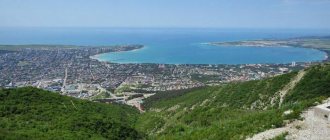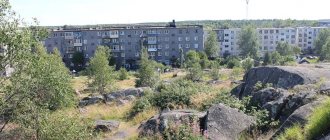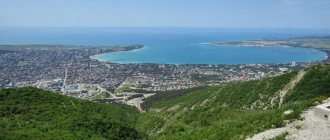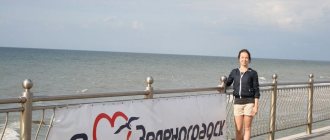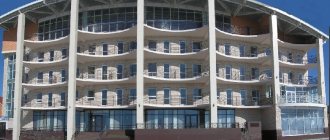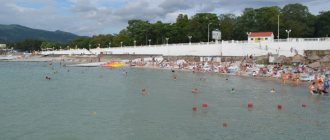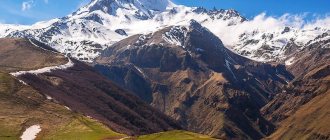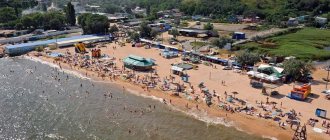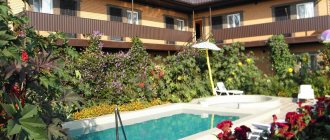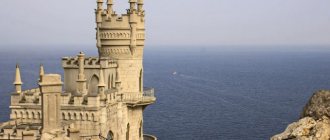The sights of Pitsunda stand before us as monuments from different historical eras. You can find anything here. Ancient Greek stones, echoes of the semi-mythical past of Abkhazia in a modern interpretation and architectural fantasies of the times of socialism, when this resort city was an exemplary all-Union health resort.
All man-made creations are perfectly integrated into the nature of Pitsunda with its long summers, centuries-old pine trees and natural clean lakes.
A few facts about Pitsunda
- Pitsunda is a resort town in Abkhazia, located on Cape Pitsunda, on the Black Sea coast.
- The city belongs to the Gagra district, the distance to the city of Gagra is 20 km.
- The former names of Pitsunda are Pitiunt, Sotirioupolis.
- Pitsunda received city status in 2007.
- The symbol of Pitsunda is a long-leafed relict pine.
- The beaches in Pitsunda are mostly pebble, as throughout Abkhazia.
- The population of Pitsunda is approximately 4.2 thousand people.
- The following films were filmed in Pitsunda: “Scarlet Sails”, “The Beginning”, “Guest from the Future” and others.
- From Pitsunda to the capital of Abkhazia Sukhum - 80 km, to the resorts of Gudauta - 45 km, New Athos - 60 km.
Natural attractions
The Abkhazian city of Pitsunda is located on the Black Sea coast. Once you visit, you will discover a lot of new things and take an amazing journey.
In the vicinity of the resort, countless natural resources are collected and objects of national significance are located. Those located near the lake seem to be dozing peacefully. Centuries-old trees grow. Waterfalls and rivers are noisy.
Pitsunda-Mussersky Reserve
The reserve was taken under state protection in 1910. Measures to protect nature began to be taken in 1926. It is surrounded by endangered species of pine trees, as well as oaks, beeches, hornbeams, strawberry trees, and chestnuts. In general, the reserve resembles a vast forest, fed by the Ryapsha River and Lake Inkit. The age of growing trees is 50-200 years.
Location - northwestern part of Abkhazia.
Great Pitiunt Nature Reserve
Those who like to visit historical places should definitely take a look at Great Pitiunt. Tourists will be able to get acquainted with castles and military barracks, Roman baths, ancient wells, and an ancient Christian temple. The entire area is surrounded by a 1.5 m high stone wall.
In the historical museum you can look at the preserved parts of the Cathedral of St. Andrew the Pristine.
Location: the center of Pitsunda.
Relict pine grove
Relict pines with unusually long needles occupy 200 hectares of area. Each tree is numbered. The oldest species even have their own names. For example, one of them is called “Patriarch”. Not long ago we celebrated our anniversary – 5 centuries. The relict grove is the jewel of the Abkhazians. They carefully monitor the safety of each tree.
Some species of ancient coniferous trees are listed in the Red Book.
Evergreen trees, when heated in the sun, release resin, exude phytoncides, and impart aromatic healing properties to the air in the grove. The smell of sea and pine mixes to create a healing cocktail that is useful for people with colds in the off-season and respiratory tract pathologies.
Be sure to visit the pine forest and take a walk along the wild beach. To get there, just walk along the cypress alley of Pitsunda towards the sea.
Location: the territory of the Pitsunda Nature Reserve, along a 4 km long coastline.
Bamboo Grove
The only natural site in Abkhazia where bamboo grows. The grove is considered a state property. Local authorities monitor its safety. The height of some bamboo specimens reaches 35 m.
Location: Pitsunda resort village, not far from the Central Beach.
Pitsunda embankment
The embankment, after which the street is named, is referred to by local residents as the pearl of Abkhazia. Tourists are attracted by the magnificent landscapes, flower beds with exotic plants, tall palm trees, and pine trees growing near the shore, which exude an amazing aroma when mixed with the salty sea air.
The embankment is a cozy place in the resort where you can relax and walk along the road paved with paving slabs. In the evening, street musicians help diversify your leisure time. When visiting the embankment, unique views of the mountains, hills, and bay open up.
Don’t forget to take a photo with the nearby statues “Divers”, “Pearl Swimmers” / Medea is located within a 15-minute walk.
Today it is not necessary to walk around the resort. If you wish, you can take a breeze on a cruising train.
Location - along the sea, behind a beautiful pebble beach.
Lake Inkit
A relict lake created by nature itself. The lake appeared about 2000 years ago, after the impacts of the sea surf. At first, the water in the reservoir was fresh. Today – lightly salted.
The air in these parts is humid, so malarial mosquitoes used to annoy tourists. But soon the locals introduced Gambusia. The fish gradually ate all the mosquitoes and larvae. Now the pond is clean. Of course, it is small, shallow, and not particularly picturesque. But it has a rich history.
It was along it that the ship of the Macedonian commander sailed in the 4th century.
In the salt lake Inkit there are herons and worms. These are endangered species of animals listed in the Red Book.
Location: Cape Pitsunda, a few kilometers from Pitsunda.
Lake Ritsa
Ritsa is the pearl of Abkhazia. It appeared after a strong earthquake, a partial collapse of Mount Pshegishkha, which blocked a once flowing mountain river.
There are legends around the lake. They say that at the bottom lies the girl Ritsa, a drowned woman. The mountains around the circumference are her brothers. Read more about the legends and secrets of Lake Ritsa.
There is a lot to see in this area:
- ancient tower “Ha-san-Abaa”;
- unique blue lake;
- the ancient village of Bzyb, if you walk along the ancient trees, look at the remains of a fortification structure located at the foot of the hills.
One of Stalin's dachas is located on Lake Ritsa. This is a one-story building of 4 rooms in an architectural, laconic style. Among the thickets of greenery, Commander-in-Chief Stalin visited the dacha.
Location - not far from the Black Sea coast, surrounded by the Caucasus mountains.
Bzyb River
A deep river with steep, dangerous descents. To cross the water there is a bridge - a shaky path. Only daredevils dare to walk along it.
Bzyb is a convenient place for fishermen and salmon floodplains. For those who go rafting, there is an excellent place with dangerous descents near Pitsunda. Although it is better for beginners to hire an experienced instructor. Safety comes first here.
Location: Western Caucasus, territory of Abkhazia. It originates in the mountains at an altitude of 230 m and collects water from the slopes of the Caucasian ridge.
Geg waterfall
Gegsky Waterfall is a unique place, a miracle of nature, beloved by Soviet directors. It appeared after a tunnel was made in the rock mass in one area by a river flow. The stream broke out from the back of the rock. Now the icy water falls from the cliff, rumbling, pouring out of the cracks in the wall. Forms a rainbow, sparkling in the rays of the sun.
You can walk along the waterfall on foot, take a photo as a souvenir, and see picturesque places. All the beauty is visible in full view if you stand on the observation deck.
Access to the observation deck is paid. The cost of visiting per person is 45 rubles.
Location - the slopes of the Gagra ridge, 5 km from Lake Ritsa.
First Gorge
Local residents call the gorge “Monastic”. Monks lived there, wanting to retire. Today there is a beach nearby where you can relax, indulge in diving, and go crabbing on the reefs. Restless tourists can hike through the gorge or soak in the warm Black Sea.
Location: Agarki village, not far from Pitsunda.
Yupshar Canyon
A place that will take your breath away. This is a fascinating natural monument of mountainous Abkhazia, formed in a huge rock. In summer it is calm and cool there. In the heat, the river becomes shallow, and the rocky bottom of the gorge is visible. In rainy weather, Yupshara overflows, ready to show her soft disposition.
The formation of huge cracks in the rock was influenced by an earthquake that occurred hundreds of years ago. The waters of the rivers have smoothed the base of the rocks over the years. The slopes are overgrown with ivy, red moss, and boxwood.
The canyon is called a “stone bag”. If you stand close, it seems that the high rocks are about to close overhead and capture you for centuries. The beauty and monumentality of the canyon attracts hundreds of tourists every year. The huge majestic rocks cannot but arouse admiration with their grandeur. Not far from the Yorkshire Canyon, the waters of the Gega River fall through the gorge, forming the charming Gega Falls from the rock.
Location - Gudauta region of Abkhazia.
Pitsunda Bay
The bay is the main pier of Pitsunda beach. Gives you the opportunity to go on a sea voyage along the Black Sea along the coast on an excursion boat. Look at the breathtaking views of mountain gorges and pine groves. It's fun to take a romantic morning walk. At this time you can see dolphins.
The ship is equipped with a bar, which will certainly offer delicious drinks.
Location: Caucasian coast of the Black Sea.
Waterfall of maiden tears
Maiden's Tear is one of the beautiful waterfalls of Abkhazia. Named according to the legend according to which the girl Amra once lived near the Bzyb River and was the lover of the young man Akhra. But she died at the hands of an evil mermaid. Now the water from the waterfall is the girl’s tears.
Having visited this place, you can make a wish. For execution, attach a multi-colored ribbon. The water in the lake is always clean and fresh. And this is not surprising. The waters have to overcome a path through limestone rocks, then pass through high-mountain meadows.
Location - on the way to Lake Ritsa.
Waterfall of men's tears
This is a small but picturesque site with a single stream. Tourists rush to it to tie ribbons, make wishes, and touch the streams of water falling from above, standing on the bridge, which is located near the waterfall.
This place is always crowded. The object is considered popular among couples. There are many legends surrounding it. One of them is “girlish” and “male tears”. The story is about a young girl Amra and Adgur, her lover. Once upon a time a young man was hunting in the mountains. He felt that his girlfriend was in danger. Realizing that he couldn’t help, he shed a few tears. They fell on a stone and later turned into a wonderful waterfall.
Location: Ritsa Nature Reserve (Abkhazia), highway leading to Lake Ritsa.
Sights of Pitsunda
What to see and where to go in Pitsunda? Let's take a closer look at the sights of Pitsunda. Here you can stroll along the embankment, look at the sculptures “Divers” and “Medea”, and go to the old lighthouse. In Pitsunda there are the ruins of the ancient Greek city - the Great Pitiunt, the temple of St. Andrew the First-Called and a dolphinarium. The air in Pitsunda is especially healthy thanks to the relict pine grove.
Beaches of Pitsunda
Even at the height of the season, there are free places on the long and wide beaches of Pitsunda. The “central” beach is considered the best in the resort city. It's paid, so it's civilized. Can:
- rent a sun lounger;
- use the shower and changing cabin;
- have lunch or breakfast in a cafe;
- take a walk on the sea or purchase a sea excursion to Stalin's dacha .
The water on the beaches of Pitsunda is clean, warm, and the air is unique. Fans of active recreation are offered a classic range of entertainment - parachute flights over the sea, scooters, banana boats, catamarans. The beaches of Pitsunda are a place for relaxation. It is beautiful, spacious, and there are few people.
Great Pitiunt
In the area of modern Pitsunda, there once stood the ancient Greek city of Pitiunt, which was founded on the site of settlements of the 4th century BC. e. Then, in the 2nd century AD. e., the city was occupied by the Romans. Then, at different times, the city of Pitiunt was part of the Abkhazian kingdom, Georgia and the Ottoman Empire. And in the 19th century it became Russian.
Historical centuries and civilizations have left their mark on this ancient city. Now the historical and architectural complex “Great Petiunt”, like an open-air museum, preserves buildings from different eras. Here you can find the remains of ancient houses, Roman baths, medieval fortress walls and an ancient Christian temple.
Museum of History
On the territory of Pitiunta there is a museum of the history of Pitsunda , which can be visited as part of a tour of this historical complex, having paid the entrance fee.
The museum is located in a building where there was a monastery in the 19th century. Finds made on the territory of the ancient city during archaeological excavations are exhibited here. The found tools date back to the Stone and Bronze Ages.
More recent finds include coins, glass and ceramics. In the museum you can see original Pitsunda mosaics, original frescoes, icons and paintings.
Fans of the ethnographic past will be interested in visiting the private
museum of Giorgi Khetsuriani , also known as the “Old Mill” , named after the tavern and guest houses located right there.
The owner of the museum collected exhibits for many years throughout the USSR. These are the most ancient Abkhaz tools for cultivating the land, characteristic models of rural buildings, historical postcards and photographs, and a collection of samovars.
One of the central places in the rich collection is occupied by a Mercedes phaeton , in which tourists rode around Pitsunda in the 30s of the 20th century.
Entrance fee is 100 rubles. The museum is located in the suburbs of Pitsunda , Ldzaa district , on Adamiya Street 3. Minibuses go to Ldzaa from the central square of Pitsunda.
Pitsunda Temple
Cathedral of the Apostle Andrew the First-Called
Address: Pitsunda, st. Gitsba, house 8.
Within the perimeter of the Great Pitiunt complex is the Cathedral of the Apostle Andrew the First-Called, which is better known as the Pitsunda Temple. The temple, built in the 10th century, attracts not only its beauty and majesty, but also the organ concerts that take place in it.
Relict pine grove
Millions of years ago, the entire territory of modern Abkhazia was occupied by a prehistoric forest of relict pine trees. Now all that remains of it is a grove with an area of about 200 hectares and a length of 7 km, which hugs Pitsunda on three sides.
The Abkhazians call their unique grove Amzara, which means “ancient pine forest.” All the trees in this forest have a serial number, and there are about 30 thousand of them in the grove. Basically, pine grows for about 100 years. But there are also long-lived trees that have been alive for two centuries. The oldest pine tree was given the name “Patriarch”. The tree is already 500 years old, it reaches a height of 50 meters, and the girth of the trunk is 7.5 meters.
Pitsunda pine is an ancient coniferous tree with unusually long needles of 12-18 cm. Heated by the hot Abkhaz sun, the resin of the relict pine releases special substances that suppress the growth of pathogenic bacteria. It is these substances, called phytoncides, that make the air of Pitsunda truly miraculous and healing.
Neighborhoods of Pitsunda
Microdistrict "Rybzavod"
Address: Gagra district, Lidzava village (Ldzaa) How to get there by car: along the Lidzava highway northeast of Pitsunda By public transport: buses and minibuses run regularly to Lidzava. The cost of travel by bus is 8 rubles, by minibus - approximately 20 rubles.
To fully experience the leisurely atmosphere of the Abkhaz coast, visit the Rybzavod microdistrict in the village of Lidzava not far from Pitsunda. The fish factory itself has long been closed, all that remains is its name.
The famous Pitsunda pine grows everywhere here, the smell of which envelops the entire eastern coast of the cape. This aroma, combined with mountain air and the smell of the sea, has a healing effect and benefits people with respiratory system diseases.
Holidays at the “Rybzavod” involve accommodation in the private sector, where you can see livestock walking on the streets, and you can buy homemade products inexpensively from local residents.
Sculptural composition “Divers”
The embankment of Pitsunda Street, 5 km long, is completed by the sculpture “Pearl Divers”. Three-meter arches imitate waves on which the figures of a young man and a girl seem to hang, surrounded by dolphins and fish. Young people reach out to the shell where the pearl should be, and a fountain gushes out of it.
The art object created by the Georgian sculptor Irakli Ochiauri has long become a symbol of an eternally young summer and carefree holiday. But at the time, the sculpture was not opened right away, because according to officials, Soviet boys and girls do not swim naked, like the “Divers.”
Lakes Ritsa
Vacationers who stay in the city of Pitsunda are not left indifferent by the surroundings of this place because of the incredible beauty of the nature of Abkhazia. Almost every tourist vacationing here must visit Lake Ritsa, which is located in the mountains at an altitude of 1000 meters. It is noteworthy that the lake is very young by natural standards - it was formed only 250 years ago.
Today it is the most popular attraction in Abkhazia. The water in the lake is cold even on the hottest day, but all the tourists still take a dip in the reservoir. If you don’t want to swim, you can rent a boat or catamaran.
The lake is located north of Pitsunda, the distance to it is about 59 kilometers. Drive just over an hour along the E-60 highway. Along the way, you will come across another attraction in the vicinity of the city - the Maiden's Tears waterfall.
IMPORTANT! The route passes through the Yukhinskoye Gorge. If you go in winter, be extremely careful, there may be an avalanche. And the road to the lake itself is very difficult in winter; many cars cannot get there because of the snow.
Sculpture "Medea"
According to archaeological research, the legendary Colchis from ancient Greek myths was located somewhere in Abkhazia. Perhaps Pitsunda was the birthplace of the Colchian princess Medea, a beautiful and fierce sorceress. For the sake of her beloved Jason, who arrived on the shores of Colchis on the ship "Argo", she betrayed her father, killed her brother and committed many more crimes. But Jason left Medea to marry another and become the rightful king. Abandoned Medea took terrible revenge: she poisoned her bride and killed her children from Jason.
In the south of Cape Pitsunda, almost at the very edge of the coast, there is a 5-meter bronze sculpture “Medea”, created by national artist Merab Berdzenishvili. The Colchis princess-witch is depicted at a fateful moment: she is now deciding to take cruel revenge. She is huge and black, like her love and hatred for Jason. She still holds her children close to her with impossibly large hands, but will soon take the sword tied to her hip.
Pitsundo-Myussersky Nature Reserve
If we talk about what to see in Pitsunda on your own by car, then many experienced tourists advise going to the Pitsunda-Mussersky Nature Reserve. This beautiful place is located in Abkhazia about 30 kilometers from Pitsunda, the journey by car will take no more than an hour. Without traffic jams, experienced drivers can get here in 40 minutes. You need to go to the reserve along the E-60 highway, and then turn right onto the road called Musera Road.
Both Pitsunda itself and the surrounding area of the city are very picturesque, so along the way you will see many beautiful landscapes, especially since part of the route passes along the Black Sea coast.
The reserve is famous for the fact that Pitsunda pine grows here; the forest occupies over 3,500 hectares. There are also about 800 species of plants, including rare relict ones:
- cypress trees;
- boxwoods;
- Georgian oak.
IMPORTANT! Tourists note that it is best to come to the reserve in late spring or early autumn. Then you will see all the diversity of plants and will be able to walk around the reserve without the sweltering heat.
Pitsunda lighthouse
At the end of the 19th and beginning of the 20th centuries, a 36-meter lighthouse was built on Cape Pitsunda. For quite a long time he showed the way to ships looking for a way to Pitsunda Bay - until the end of the 1960s.
Now it is not functioning and its doors are securely closed from visitors. The structure has long since rusted; winds, rains and sea air have battered the tower, and it is supported by supports. But despite the deplorable non-functional state, the lighthouse became a symbol of the resort city.
Notable buildings
Ruins of Pitiunt
On Cape Pitsunda in the 2nd century BC there stood the ancient city of Pitiunt. Today, the ruins of the ancient settlement are part of the Great Pitiunt Nature Reserve, where there are younger buildings. In the center of the complex there is a temple surrounded by powerful flagstone walls, built in the 10th century.
Also noteworthy is the 18th century chapel, a unique large organ and a dolmen for burials. The complex is surrounded by a fortress wall that protected the city from enemy attacks.
Pitsunda lighthouse
The lighthouse was built at the beginning of the last century and for a long time illuminated the way for ships at night. Today it no longer works - now its functions are performed by a signal tower on one of the buildings of the boarding house located nearby.
The lighthouse stood exposed to the sea wind for many years, so its structure had time to rust. But despite its modest appearance, it remains a popular attraction and symbol of Pitsunda.
READ ALSO
14 best attractions in Mtskheta
Dacha Gamsakhurdia
In Pitsunda there is a summer cottage of Konstantin Gamsakhurdia, a Georgian writer and academician of sciences. During his lifetime, the author loved to spend time here, relax, reflect and create. Perhaps it was at this dacha that he found ideas for his best works.
Today the house has owners, but is visited quite rarely and is mostly empty. Not far from it is the dacha of E. Shevardnadze.
Sculptural composition “Sea”
At the end of Gitsba Street, not far from the beach, there is a sculptural composition created in 1969 by Georgian sculptor I. Ochiauri.
It consists of statues of a boy and a girl diving with dolphins. Local residents gave it another name - “Pearl Divers”. The monument includes two stone arches, to which bronze figures are attached. The sculpture is installed in a place popular with tourists, so photographs are often taken here.
Gudauta Winery
In the vicinity of Pitsunda there is a small village of Gudauta, which is famous for its winery. It was built in 1953 and its products were popular. However, from the 1980s until 2010, the plant did not operate.
Today, production has started again - now it is a private winery with a tasting room where you can try Abkhaz wines and cognacs. There are interesting excursions along it, and there is also a shop on site where you can buy your favorite drink.
Dolphinarium in Pitsunda
Website: abhaziadelfinarium.com Address: Pitsunda, st. Gitsba, 5. Opening hours: daily, except Monday. Ticket price: 700 rub.
The Dolphinarium opened in Pitsunda in 2021 and has a capacity of 400 seats. It is a small pool under the open sea. Here you can watch performances with the participation of dolphins and fur seals. Performances take place at 11:00, 16:00 and 19:00.
New Athos Cave
The cave of New Athos is located under the Iveron Mountain and is one of the largest caves in the world.
Its karst cavity has a volume of almost 1 million m3. The complex system of cave labyrinths is filled with mineral formations, stalactites and stalagmites, which grow together to form stalagnates. In some rooms you can see cave lakes .
To get into the mysterious New Athos Cave, you need to stand in line, but the spectacle is worth it. You can pass the time in line by looking at New Athos through panoramic binoculars (10 rubles – 1 min).
It is quite cold in the cave - +11 degrees.
The cost of the entrance ticket is 400 rubles; before entering, those wishing to purchase a permit to photograph inside the cave need to purchase a permit for photography inside the cave - 50 rubles, otherwise they face a fine of 1000 rubles.
The underground route passes through several halls along a path of just under 2 km, after recruiting a group with the appropriate number of people. The group is accompanied by a guide.
They begin exploring the cave by taking seats on a special tourist train . The tour lasts one and a half hours.
Minibuses from Pitsunda to New Athos go from the central square, travel time is 30–40 minutes.
House-Museum of Khetsuriani
Address: Pitsunda, village. Ldzaa, st. Adamiya, 3. Ticket price: 200 rubles.
One of the attractions of Pitsunda is the Khetsuriani House Museum, which is located in the neighboring village of Ldzaa. Its founder, Georgy Khetsuriani, was the first to photograph tourists against the backdrop of the beautiful nature of Abkhazia in the 60s of the last century. Over time, the resort became popular, and the business of the Soviet entrepreneur went uphill. He spent the money he earned on creating a unique collection of labor items, household items and weapons.
The house-museum contains pottery, edged weapons, cameras, stuffed animals, Russian samovars, typewriters... It’s easier to say what is not within the walls of this amazing private museum. More than two thousand exhibits are located in a two-story house with a spiral staircase, built in 1980 specifically for the museum. The most valuable exhibit is the Mercedes phaeton of the Prince of Oldenburg.
Giorgi Khetsuriani died in 1994; his relatives look after the museum collection. They also opened the Old Mill cafe next to the museum, where you can eat inexpensively and deliciously.
Architectural heritage of the resort
Pitsunda is an ancient settlement that has survived more than one change of rulers. Every civilization from the Roman Empire to the Soviet Union has left its traces in the form of architectural structures on the Pitsunda land.
Old lighthouse
- Coordinates: 43.147487, 40.342362.
The tall metal lighthouse was built at the end of the 19th century. From 1891 to 1953, workers lit the signal fire using kerosene. In 1953, an electric floodlight appeared on the tower.
Over the many years of operation, the lighthouse has fallen into disrepair and today is not used for its intended purpose. The structure is rusty and threatens to collapse at any moment. To preserve the architectural monument, it was surrounded by metal supports. Entry inside is prohibited; the door has been welded shut for security.
Now the old tower is poorly visible from the sea, since the building is obscured by the taller buildings of the Mayak sanatorium. The name of the sanatorium fully corresponds to its new purpose: signals to sailors are now given from the roof of one of the buildings.
Esher dolmen
- Address: Topolevaya street.
Several thousand years ago, people buried their dead in small tombs - dolmens, made of five stone slabs. Ancient tombs were common on the Black Sea coast. Five dolmens were found on the territory of Abkhazia.
The Pitsunda specimen was brought from the village of Esher in the 70s of the last century and is currently stored on the territory of “Great Pitiunt”. The dolmen was damaged during transportation; the cracks between the slabs had to be filled with concrete.
Dacha K.S. Gamsakhurdia
- Coordinates: 43.167752, 40.333465.
Konstantin Simonovich Gamsakhurdia is a famous Georgian scientist and writer. The writer's country mansion has been preserved in Pitsunda. The house for the classic of Georgian literature was built in the mid-20th century. It is believed that it was in Pitsunda that Konstantin Simonovich wrote his main works. Now the house is abandoned, like many mansions nearby.
Water tower
- Address: Topolevaya street.
On the outskirts of the city, a round brick tower rises on a high hill. The date of construction - 1951 - is indicated directly on the wall; under the numbers there is a five-pointed star, one of the symbols of the Soviet Union. The building has long been abandoned, the roof has collapsed, but the walls are in good condition.
Bus stops
Public transport stops in Pitsunda are a separate form of art. In the 60s, creative people often departed from the canons of Soviet architecture and took a creative approach to doing their work. Many futuristic objects are the creations of the famous sculptor Zurab Tsereteli.
Among the most striking stops are giant structures in the shape of a rooster, octopus, and sea waves. Some shelters were damaged during the Georgian-Abkhaz War. Unusual buildings irritate many local residents, but invariably attract the attention of tourists.
Bus stops
Some bus stops in Abkhazia even now look like an unexpected greeting from the future. They are too different from the usual minimalist places to wait for public transport. And in the 1960s, when they were just built according to the designs of Zurab Tsereteli, they generally seemed like futuristic objects.
Bus stop Petushok in Pitsunda
The stops are made of reinforced concrete and decorated with bright cobalt glass mosaics. The shape resembles a giant octopus, fish, wave, rooster... But local residents did not accept such creativity of the architect. The stops were criticized and called inconvenient to use.
Now the stopping pavilions have suffered from the Georgian-Abkhaz war and the wind of times. But even if not restored and dilapidated, they still resemble artifacts of an extraterrestrial civilization scattered among the greenery of Abkhazia.
Cultural attractions and museums
House-Museum of Khertsuriani
The private house-museum is named after its founder, Giorgi Khertsuriani, a folk craftsman and collector. Among the exhibits there are stuffed animals, ancient household items, products of folk craftsmen of Abkhazia, a collection of samovars, photographs and postcards.
The highlight of the collection is a phaeton produced by Mercedes, which belonged to the founder of Gagra, the Prince of Oldenburg. In addition to the museum, the Khertsuriani complex includes a boarding house, a tavern and a hunter's house.
Patriarchal Cathedral
In the center of Pitsunda there is an architectural complex, which includes a destroyed bell tower and the ruins of a temple, as well as the famous Patriarchal Cathedral. It is distinguished by thick walls made of brick and stone blocks, which indicates that the structure was originally used for defensive purposes.
Later, signs of a cross-domed church appeared in the appearance of the building. Inside the cathedral you can see paintings on the walls and a fresco depicting the face of Christ. In the depths of the building there is a tomb where the relics of deceased saints are kept.
Pitsunda embankment
Behind the pebble beach begins the Pitsunda embankment, which stretches for as much as 5 km. A walk along it will be a great end to an eventful evening. You can enjoy the sea views or stop and listen to street performers.
You can rest on a bench under the palm trees or in a cozy gazebo, inhaling the aromas of the sea and relict pine trees. There are many shops and cafes on the embankment, as well as attractions and a 5D cinema.
Museum of the History of Pitsunda
The History Museum is part of the Great Pitiunt Nature Reserve. It is housed in a monastic building from the 19th century, which has a modest and unremarkable appearance.
At the exhibition you can look at icons and frescoes, as well as paintings depicting scenes from the life of the ancient Greeks, drawings of animals and fish found during excavations in the city of Pitiunt. All available information about the history of Pitsunda is stored within the secure walls of the former temple.
New Athos Monastery
In the vicinity of Pitsunda there is the New Athos Monastery, built in the 19th century by monks from the Russian temple of Old Athos. Two years after its construction, the building was destroyed and looted by the Turkish army. Subsequently, the temple was restored. It also has a second name - Simono-Kananitsky, in honor of one of the disciples of Christ.
Monument to those killed in the Georgian-Abkhaz war
An unusual monument was erected in a specially designated park in Pitsunda. It is dedicated to the residents of the country who died during two wars - the Great Patriotic War and the conflict between Georgia and Abkhazia in 1992-1993.
The monument is a white granite arch, the height of which is approximately 4 m. On one side of it are the names of those who died in the Second World War, and on the other - the names of people who gave their lives in the war of the 90s.

